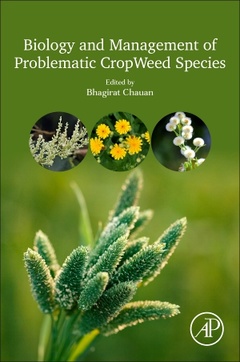Description
Biology and Management of Problematic Crop Weed Species
Coordinator: Chauhan Bhagirath
Language: English
Subjects for Biology and Management of Problematic Crop Weed Species:
Keywords
A hybridus; A palmeri; A retroflexus; A spinosus; A tuberculatus; Agricultural weed; Alternating temperature; Anaerobic germination tolerant rice; Anisantha diandra; Anisantha rigida; Annual ryegrass; Avena fatua; Avena ludoviciana; Avena sterilis; Barnyard grass; Biological control; Biological management; Biology; Canarygrass; Chemical control; Chemical management; Clean seed; Climate change effects; Common lambsquarters; Competition; Conservation agriculture; Conyza species; Crabgrass; Crop–weed competition; Cultural control; Cultural management; Digitaria ciliaris (Retz) Koeler; Digitaria ischaemum (Schreb) Schreb ex Muhl; Digitaria sanguinalis (L) Scop; Direct-seeded rice; Dormancy; Ecology; Economic and yield impact on crops; Erigeron species; Feathertop Rhodes grass; Genetic diversity; Habitat; Harvest weed seed control; Herbicide resistance; Herbicide-tolerant rice; Integrated weed control; Integrated weed management; Invasive traits; Invasive weed; Invasiveness; Ipomoea hederacea (L) Jacq; Ipomoea lacunosa (L); Ipomoea purpurea (L) Roth; Italian ryegrass; Johnsongrass; Junglerice; Life cycle; Lolium perenne ssp multiflorum; Management; Morningglory; Morphology; Nettleleaf goosefoot; No tillage; Phytotoxicity; Plant invasion; Purple nutsedge; Ragweed parthenium; Reproductive rate; Rice; Rigid ryegrass; Secondary dormancy; Seed biology; Seed ecology; Seed germination; Seed shattering; Seedling; Stale seedbed; Sterile oat; Weed biology; Weed ecology; Weed management; Weed seed; Weed seed reserve; Wild oat; Windmill grass; Winter wild oat; Yellow nutsedge; Yield reduction; Zero-till cropping
432 p. · 15x22.8 cm · Paperback
Description
/li>Contents
/li>Biography
/li>Comment
/li>
Weeds are the main biological constraint to crop production throughout the year. Uncontrolled weeds could cause 100% yield loss. In Australia, the overall cost of weeds to Australian grain growers was estimated at AU$ 3.3 billion annually. In terms of yield losses, weeds amounted to 2.7 million tonnes of grains at a national level. In the USA, weeds cost US$ 33 billion in lost crop production annually. In India, these costs were estimated to be much higher (US$ 11 billion). These studies from different economies suggest that weeds cause substantial yield and economic loss.
Biology and Management of Problematic Weed Species details the biology of key weed species, providing vital information on seed germination and production, as well as factors affecting weed growth. These species include Chenopodium album, Chloris truncata and C. virgate, Conyza bonariensis and C. canadensis, Cyperus rotundus, and many more. This information is crucial for researchers and growers to develop integrated weed management (IWM) strategies.
Written by leading experts across the globe, this book is an essential read to plant biologists and ecologists, crop scientists, and students and researchers interested in weed science.
1. Alopecurus myosuroides Huds. Taseer Ahmad, Khawar Jabran and Stephen Richard Moss
2. Biology and management of weedy Amaranthus spp. Debalin Sarangi, Amit J. Jhala, Prabhu Govindasamy and Anthony Brusa
3. Avena fatua and Avena sterilis Breanne D. Tidemann, Charles M. Geddes and Hugh J. Beckie
4. Bromus diandrus and Bromus rigidus Catherine P.D. Borger, Joel Torra, Aritz Royo-Esnal, Laura Davies and George Newcombe
5. Chenopodium album and Chenopodium murale Seyed Vahid Eslami and Sarah Ward
6. Chloris truncata and Chloris virgata Het Samir Desai and Bhagirath Singh Chauhan
7. Erigeron bonariensis, Erigeron canadensis, and Erigeron sumatrensis Singarayer Florentine, Talia Humphries and Bhagirath Singh Chauhan
8. Cyperus esculentus and Cyperus rotundus Gerald M. Henry, Matthew T. Elmore and Travis W. Gannon
9. Digitaria ciliaris, Digitaria ischaemum, and Digitaria sanguinalis Eric A.L. Jones, Diego J. Contreras and Wesley J. Everman
10. Echinochloa colona (L.) Link and Echinochloa crus-galli (L.) Beauv Adusumilli Narayana Rao
11. Ipomoea hederacea, Ipomoea lacunosa, and Ipomoea purpurea Eric A.L. Jones, Diego J. Contreras and Wesley J. Everman
12. Lolium rigidum and Lolium multiflorum Hugh J. Beckie and Marie Jasieniuk
13. Weedy rice (Oryza spp.) Masilamany Dilipkumar, Virender Kumar, Beng-Kah Song, Kenneth M. Olsen, Tse-Seng Chuah, Sharif Ahmed and Sheng Qiang
14. Parthenium hysterophorus Amarpreet Kaur, Daizy Rani Batish, Bhagirath Singh Chauhan, Shalinder Kaur, Harminder Pal Singh and Ravinder Kumar Kohli
15. Phalaris minor and Phalaris paradoxa Ankur Chaudhary, Simerjeet Kaur and Bhagirath Singh Chauhan
16. Solanum nigrum and Solanum physalifolium Alireza Taab
17. Sonchus oleraceus Gurpreet Singh Khalsa, Sahil Dahiya and Bhagirath Singh Chauhan
18. Sorghum halepense: biology and management Caleb C. Squires and Michael J. Walsh
CCS Haryana Agricultural University and Bachelor of Science (Hons) Agriculture. His research focuses on Weed ecology and seed germination biology, Herbicide use and resistance management, Tillage systems and crop establishment methods, Improving weed competitive ability of crops by optimizing the use of competitive cultivars, seeding rate, and row spacing, Integrated weed management strategies for different cropping systems.
- Provides detailed information on the biology of different key weed species
- Covers weed seed germination and emergence
- Presents the factors affecting weed growth and seed production
These books may interest you

Weed Anatomy 347.93 €

Weed ResearchExpanding Horizons 219.13 €

Atlas of Weed Mapping 247.51 €

